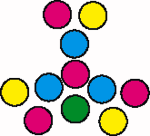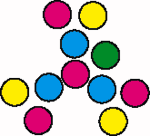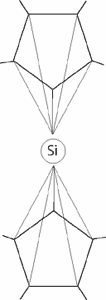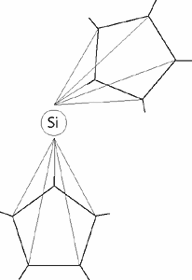by, Sithamalli K. Balasubramanian - Ph.D.
The implication of this interpretation of quartz chirality is that every compound of the type SiR4 should exhibit chirality. This is not observed in practice because the bond sites being close to each other, the bonds can pass over from one form to another with ease. The chirality would therefore be observable only in the solid state where the atomic positions would be fixed in relation to one another.
The literature on the matter of isomerism in simple silicon compounds is somewhat confused with unconfirmed but strange experimental observations. We would rather leave the matter to be settled by future and avoid comments at this stage.


Fig.1a Fig.1b


Fig.2a Fig.2b


Fig.3a Fig.3b


Fig.4a Fig.4b

Figures (2, 3, & 4) are the other possible forms 28Si which can fulfill the conditions for Silicon, namely, tetrahedral arrangement of bonds and chirality of bond sites.
Whilst form (1) had only one apex, the other forms have two apices. Each of these apices can form chiral pairs with an equatorial hextet. Thus the forms (2 to 4) can each lead to two chiral pairs or in total four optically active isomers.
The forms (1 to 4) are to be considered comparable with isomers at the molecular level. This is a new phenomenon so far unknown. We suggest the name SIOMERISM to describe it. The different forms (1 to 4) are to be known as SIOMERS.
In siomers (1 to 4) the two ‘faces’ of the atom are shown separately as ‘a’ and ‘b’. If the mirror plane in (1) is taken along the equator of the icosahedron the apex will not have a mirror image. A proton in this position would give rise to nuclear magnetism. ...top
In (2) the magnetic effects of the two apices would cancel out and the nucleus would not show any magnetic effect. Similar is the case with siomer (3). Siomer (4) would exhibit nuclear magnetism. Thus contrary to the current view some siomers of 28Si are expected to exhibit nuclear magnetism.
Photo (1a) clearly shows the presence of non-overlapping pentad groups of bonding areas. The apex is part of three pentads. Corresponding to the arrows three pentads could be identified which do not share any corners. These are arranged at an angle to each other. It is conceivable that they should lead to sandwich complexes similar to ferrocene. In fact decamethyl silicocene (5) had been reported {ref.3}. In the solid state it exists in parallel (5a) and angular (5b) forms in the ratio of 1:2. Examination of models shows that of the four siomers one (4) would not form any silicocene since it does not have suitable pentad surfaces. Two siomers would lead to angular silicocene whilst one would give rise to the parallel silicocene. Thus our model correctly predicts the ratio of the two forms also. There is some difference between the observed (5d) and the predicted (5c) dihedral angles of the cyclopentadienyl groups. This could be ascribed to the steric effects of the methyl groups.


Fig. 5a. Parallel silicocene. Fig.5b. Angular
silicocene.


Fig. 5c - Dihedral angle Fig.5d Observed dihedral.
predicted by the model angle avoiding steric effect.
The model (5c) predicts a larger dihedral angle of about 50 between the planes of the rings. The steric interference between the methyl groups would lead to a realignment of the rings as shown in (5d) leading to a smaller dihedral angle of 25 as observed.
The authors ascribe the formation of two silicocenes to “packing effects” in the crystal whereas on our model they are independent molecules. They should be capable of existence in solution and be separable, effectively meaning the separation of siomers. After separation the two parts should lead only to angular or parallel silicocene exclusively. Similarly the siomer that does not form the silicocene should be capable of separation from the rest by the working up of the part of the reaction mixture that does not form silicocene.
REFERENCES:
- S. K. Balasubramanian, Previous paper.
- A. F. Wells, Structural Inorganic Chemistry, 5th ed., (1984) p.1006.
- P. Jutzi, D. Kanni, and C.Kringer, Angew. Chem. Int. Ed., 1986, 25, 164.
Supporting information: Note added on solid state chirality: A nitrogen compound had been prepared in chirl solid state forms. The chirality persists in solution also. The observation needs confirmation. The details are sent alongside for review.